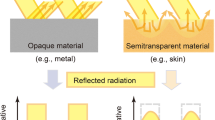Abstract
An individualised laser skin treatment may enhance the treatment and reduces risks and side-effects. The optical properties (absorption and scattering coefficients) are important parameters in the propagation of laser light in skin tissue. The differences in the melanin content of different skin phototypes influence the absorption of the light. The absorption coefficient at the treatment wavelength for an individual can be determined by diffuse reflectance spectroscopy, using a probe containing seven fibres. Six of the fibres deliver the light to the measurement site and the central fibre collects the diffused reflected light. This is an in vivo technique, offering benefits for near-real-time results. Such a probe, with an effective wavelength band from 450 to 800 nm, was used to calibrate skin-simulating phantoms consisting of intralipid and ink. The calibration constants were used to calculate the absorption coefficients from the diffuse reflectance measurements of three volunteers (skin phototypes, II, IV and V) for sun-exposed and non-exposed areas on the arm.





Similar content being viewed by others
References
Pfefer TJ, Matchette LS, Bennett CL, Gall JA, Wilke JN, Durkin AJ, Ediger MN (2003) Reflectance-based determination of optical properties in highly attenuating tissue. J Biomed Opt 8:206–215
Fabrizio M et al (2010) 2010. In: Light propagation through biological tissue and other diffusive media: theory, solutions, and software. SPIE Press, Bellingham, WA, pp 9–23
Zonios G, Dimou A (2006) Modeling diffuse reflectance from semi-infinite turbid media: application to the study of skin optical properties. Opt Express 14:8661–8674
Johns M, Giller CA, German DC, Liu H (2005) Determination of reduced scattering coefficient of biological tissue from a needle-like probe. Opt Express 13:4828–4842
González FJ, Martínez-Escanamé M, Muñoz RI, Torres-Álvarez B, Moncada B (2010) Diffuse reflectance spectrophotometry for skin phototype determination. Skin Res Technol 16:397–400
Costin GE, Hearing VJ (2007) Human skin pigmentation: melanocytes modulate skin color in response to stress. FASEB J 21:976–994
Alaluf S, Heath A, Carter N, Atkins D, Mahalingam H, Barrett K, Kolb R, Smit N (2001) Variation in melanin content and composition in type V and VI photoexposed and photoprotected human skin: the dominant role of DHI. Pigment Cell Res 14:337–347
Agache P, Humbert P (2004) Measuring the skin. Springer, Heidelberg, pp 473–474. ISBN 3-540-01771-2
Fitzpatrick TB (1988) The validity and practicality of sunreactive skin type-I through type-VI. Arch Dermatol 124:869–871
Prahl S, Oregon Medical Laser Centre website: http://omlc.ogi.edu/. Accessed 24 November 2011
Jacques S, Oregon Medical Laser Centre website: http://omlc.ogi.edu/. Accessed 24 November 2011
Zonios G, Bykowski J, Kollias N (2001) Skin melanin, haemoglobin, and light scattering properties can be quantitatively assessed in vivo using diffuse reflectance spectroscopy. J Invest Dermatol 117:1452–1457
Flock S, Jacques S, Wilson B, Star Wvan Gernert M (1992) Optical properties of Intralipid: a phantom medium for light propagation studies. Lasers Surg Med 12:510–519
van Staveren H, Moes C, van Marie J, Prahl S, van Gemert M (1991) Light scattering in Intralipid-10 % in the wavelength range of 400–1100 nm. Appl Opt 30(31):507–4514
Karsten A, Singh A, Braun M (2011) Experimental verification and validation of a computer model for light–tissue interaction. Lasers Med Sci. doi:10.1007/s10103-011-0926-x
Michielsen K, De Raedt H, Przeslawski J, Garcia N (1998) Computer simulation of time-resolved optical imaging of objects hidden in turbid media. Phys Rep 304:89–144
Tuchin V (2007) Tissue optics: light scattering methods and instruments for medical diagnostics, 2nd edn. SPIE Press, Bellingham, WA, pp 165–175
Coleman T, Li Y (1994) On the convergence of reflective Newton methods for large-scale nonlinear minimization subject to bounds. Math Program 67:189–224
Coleman T, Li Y (1996) An interior, trust region approach for nonlinear minimization subject to bounds. SIAM J Optimiz 6:418–445
Amelink A, Sterenborg H, Bard M, Burgers S (2004) In vivo measurement of the local optical properties of tissue by use of differential path-length spectroscopy. Opt Lett 29:1087–1089
Zonios G, Bassukas I, Dimou A (2008) Comparative evaluation of two simple diffuse reflectance models for biological tissue applications. Appl Opt 47:4965–4973
Star W (1997) Light dosimetry in vivo. Phys Med Biol 42:763–787
Tseng S, Bargo P, Durkin A, Kollias N (2009) Chromophore concentrations, absorption and scattering properties of human skin in-vivo. Opt Express 17:14599–14617
Simpson C, Kohl M, Essenpreis M, Cope M (1998) Near-infrared optical properties of ex vivo human skin and subcutaneous tissues measured using the Monte Carlo inversion technique. Phys Med Biol 43:2465–2478
Acknowledgments
The authors would like to acknowledge Mr. Bafana Moya for the work in the laboratories.
Author information
Authors and Affiliations
Corresponding author
Rights and permissions
About this article
Cite this article
Karsten, A.E., Singh, A., Karsten, P.A. et al. Diffuse reflectance spectroscopy as a tool to measure the absorption coefficient in skin: system calibration. Lasers Med Sci 28, 437–444 (2013). https://doi.org/10.1007/s10103-012-1079-2
Received:
Accepted:
Published:
Issue Date:
DOI: https://doi.org/10.1007/s10103-012-1079-2




